Since time immemorial hairs have been considered as an integral part of a person’s beauty, irrespective of sex. In ancient times, even males in different cultures have been known to keep long hairs. The Hebrew Bible even has a story of Samson & his lady love - Delilah. The story describes, the super human strength of Samson, the secret of which was in his long hair. The fascination with hair was present even in the ancient Egyptian rulers . The pharaoh always wore a wig and his sons, had their hairs tied in a bun, just behind their right ear. The ancient Egyptians used a mixture of hippopotamus dung and crocodile fat, for treatment of Baldness. Hippocrates, the ancient Greek Physician described the relationship between hair loss by noticing the fact, that eunuch never suffered any hair loss. The early Christian priests shaved off a portion of their head (which was called tonsure), which was a symbol of their disdain for worldly pleasures and riches and dedication to god. In Asia too, this sentiment was reflected in Buddhist monks, who shaved off all their hairs.
Androgenic alopecia is one of the most common form of baldness that can be seen both in males and females. When it occurs in males, it is also called male pattern baldness. For this baldness to manifest, three factors are essential. These are - Genes for hair loss, Correct presence of male sexual hormones and - passage of time. The hairline of males generally recede backwards, with age and after a certain stage stabilises. In males predisposed to develop baldness, the recession of hairline does not stop and continues backwards. Hair loss specially affects frontal scalp, bilateral temple areas and the crown areas. Associated illness , deficiency of essential vitamins and malnourished state exacerbate the hair loss situation. Coronary heart disease, prostate enlargement, diabetes, hypertension (increased blood pressure), obesity (increased weight) are some conditions, which have been seen to be closely associated with androgenic alopecia.
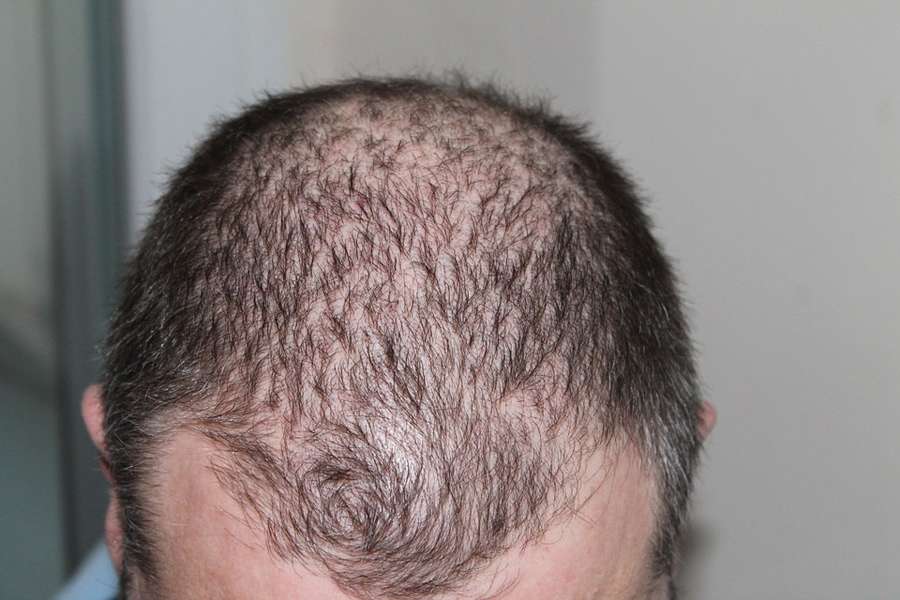
The same condition described previously is called female pattern baldness, when it occurs in females .The hair loss pattern in female is different than what happens in males. There is no recession of hairline and predominant hair loss in bilateral temporal areas of head, like that of the male does not occur; Instead hair loss is more diffuse, involving the entire scalp. So the final result is decrease in the density of hairs & thinning of hair, all over the head. Most significant hair loss is seen in the crown area. In females, PCOD (Polycystic Ovarian Disease) is very commonly associated with this kind of hair loss and has other features like- acne, irregular menstruation, weight gain and abnormal excess hair growth in other parts of the body (a condition known as Hirsutism).
Researchers have identified the main reason for this kind of hair loss, is because of the main sex hormone in men, better known as androgens, specially dihydrotestosterone. Androgens help in sex organ development of males before birth & also during puberty. Besides it is also responsible for growth of hair and sex drive. Dihydrotestosterone (DHT) acts on the hair follicle cells, by binding to special sites on it’s surface to initiate changes that causes balding. The final end result is thinning and falling of hair, when DHT level is in excess.
This is a type of hair loss characterised by focal circumscribed patchy areas of hair loss, usually found in the scalp, but sometimes occurring in other parts of the body too. The skin of the involved area does not show any textural change. Both the sexes are involved. The basic problem lies with the immune system of the body, which fails to differentiate between, invading foreign agents from body’s own cell, a condition, which is known as autoimmune diseases in medical parlance.
In this form of the disease, the malfunctioning immune system acts against the cells of hair follicles, damaging them and disrupts the normal hair formation. This causes hair loss, which in most cases is temporary and hair grows back spontaneously within a year; in some rare cases, it can be permanent. Sometimes some other associated medical problems may be present because of the autoimmune disorder. These may be - ulcerative colitis, rheumatoid arthritis, vitiligo, lupus, diabetes and hyperthyroidism. The treatment of these medical diseases, doesn’t effect the course of alopecia areata.
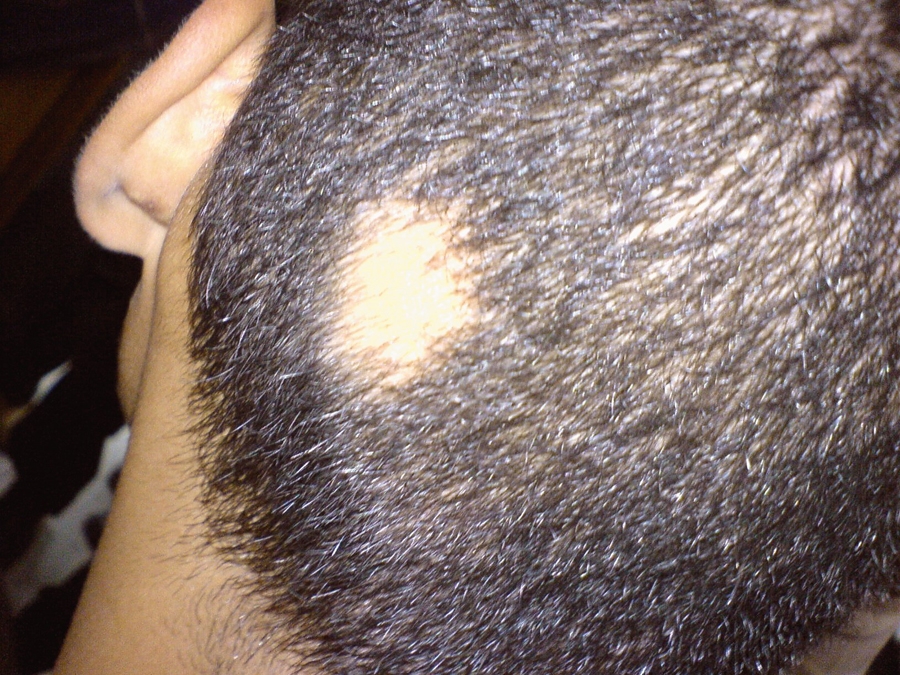
The disease is not contagious and usually affects mostly middle age adults between 30 to 60 years of age, although no age group is absolutely safe from it’s manifestation. Local steroid injection in affected areas, have been found to be helpful for hair growth.
The word traction means pulling some parts of body, forcefully. So this is a form of hair loss caused by constant traction or pulling of hair roots. This is usually due to faulty hairstyles in forms of pony tails or tight braids, which causes severe traction force on the hairs, causing them to fall out. If this is allowed to continue for long duration, it may cause the damage to be permanent. So these faulty hairstyles should be recognised as soon as possible and corrected and replaced by another method, that relieves the force on the hairs.
This is a psychological disorder, characterised by uncontrollable urge to pull out one’s hair. This causes often visible hair loss in a person. The hairs of the scalp & areas around the eyes, are frequently involved. The area involved clearly show broken strands of hairs. The disorder commonly affects women more than men and may also be found in closely associated family members. Psychological treatment and antidepressant and antianxiety medications can be helpful.
Tinea capitis also known as ringworm of the hair or scalp ; signifies the fungal infection of the head (or scalp), which commonly affect school going children. Typically the hair shaft is invaded by dermatophytes (fungus). It has been seen to affect people of African descent more commonly than other ethnicities. The area involved has dermatitis of the skin and broken hair fragments, manifesting as single or multiple patches of hair loss. Sharing caps or combs helps in spread of the disease, as the disease is infectious. Treatment is in form of antifungal medications (Griseofulvin, fluconazole and itraconazole), which are administered orally and cures the infection, by penetrating the hair roots and eradicating the fungus responsible.
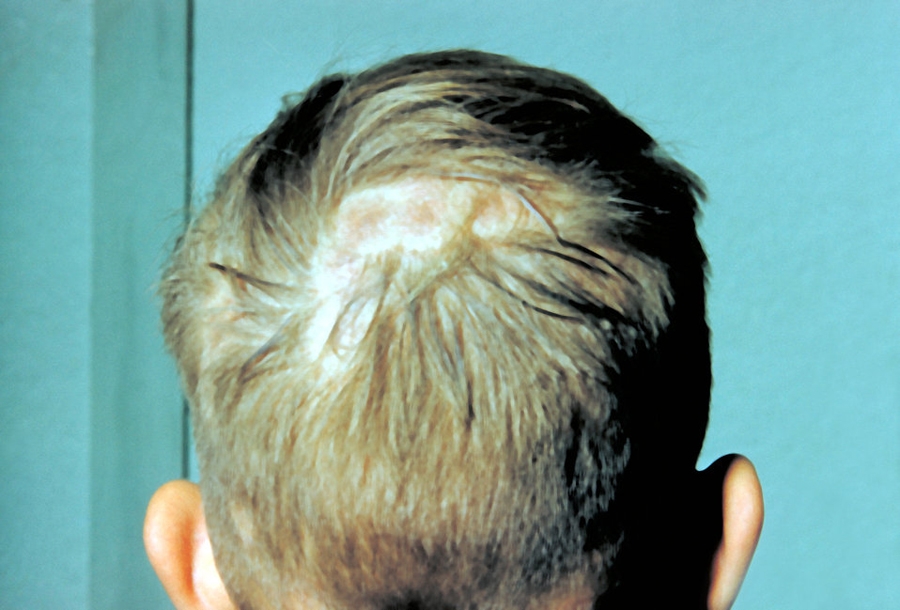
This is characterised by thinning of hair, which may be localised to one area or is generalised and is usually seen in, conditions of emotional or physical stress (which is again because of multiple reasons).
The hair cycle consists of typically three phases - 1) Anagen (Growth Phase) 2) Catagen (Transitional phase) and 3) Telogen (Resting phase). In normal condition approximately 10% hairs are in telogen phase. But in times of stress, the hair cycle is disturbed and almost 30% to 40 % hairs enter the telogen phase. This results in increased loss of hairs of the scalp (which occurs 3 months after the precipitating event), but the hair loss is never total. As these occur because of temporary shock to body, so are reversible, when the conditions (precipitating hair loss) reverts back to normal. This condition is more noticeable in females, as compared to males.
The precipitating factor may be one or more of the following - Severe emotional stress and mental disturbances, Poor diet (which is low in protein, iron, vitamin B complex and zinc - elements which promotes hair growth), significant weight loss in short period, pregnancy and childbirth, menopausal period, poor health conditions and high fever, side effects of certain drugs (medications for hypertension, oral contraceptives and antidepressants are the most commonly implicated), intake of metallic toxins and surgical stress to the body.
The affected people may be alarmed by hairs on the pillow and hairs coming out while shampooing & blocking the drains of the bathroom. But there is no reason to panic, as these hairs were pre destined to fall and hairs would grow back, once the responsible factor is eliminated or solved.
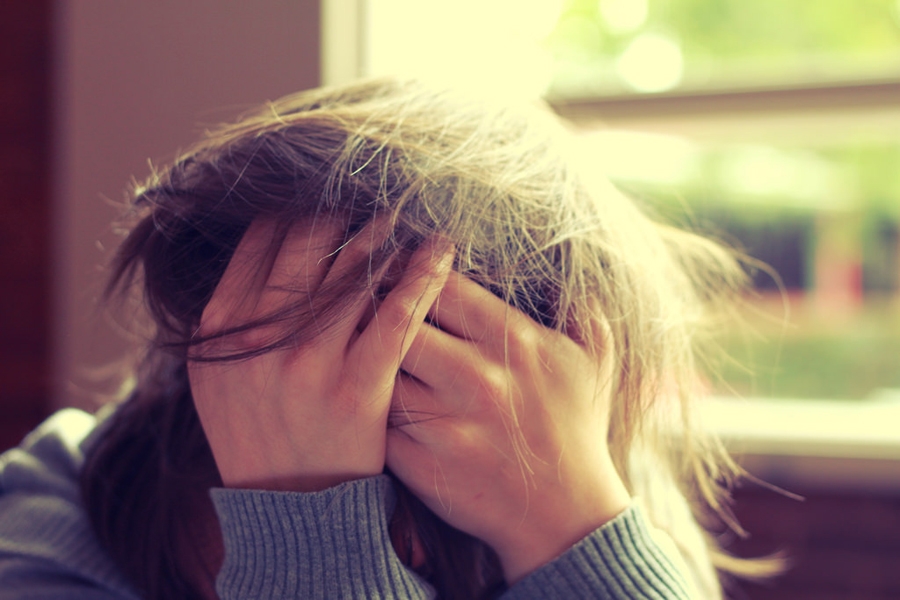
In contrast to the previously discussed reason of hair loss; the hair loss in this case occurs during the Anagen or growth phase of hair cycle. The onset of this kind of hair loss is rather abrupt & much hairs of the scalp, eyebrows, eye lashes and body hairs are lost. The resulting baldness of scalp is of much more severe degree. This kind of hair loss, is commonly seen during treatment of cancer by chemotherapy drugs(doxorubicin, bleomycin and cyclophosphamide are typical examples) and radiation. This kind of hair loss is also seen due to some autoimmune disease, infections (fungal infection by tinea capitis) and other toxins (gold, arsenic and thallium are the commonly implicated poisons). In case of infections, the area involved may be swollen or crusted, and even abscess may form. Loose hairs can easily be obtained from the infected area. Regrowth of hairs in these cases may be unsatisfactory. The history of the patient easily points to this type of hair loss.
This type of hair loss is characterised by physical destruction and permanent loss of hair follicles with associated scarring of the tissues (as the hair follicle is destroyed and replaced by scar tissue). The changes take place on deeper level, so no visible scar is present on the superficial skin, but the hair loss is permanent. The onset of hair loss may be so slow that it is imperceptible in the beginning ; but sometimes it can also present with severe itching, pain and burning sensation which progresses rather fast.
This type of hair loss, which is also known as cicatricial alopecia, can involve both sexes and no age is spared from it’s manifestations, although it is not contagious. This type of hair loss occurs in healthy persons and is not associated with any other diseases (Primary cicatricial alopecia). For these reasons, it is very difficult to come to a correct diagnosis, without biopsy study. In some cases destruction of hair follicle is because of some external precipitating causes like - Severe burns, radiations, some severe infections or tumours. This variant is called secondary cicatricial alopecia.
The first thing you should know for searching for the correct doctor, is practitioner of which branch of medicine to approach. The first requirement is to establish the diagnosis and cause of hair loss. An experienced dermatologist (Skin doctor/skin specialist) is the doctor, who would identify the cause of your hair loss and formulate the treatment.

The treatment of your hair loss, depends on the cause of hair loss. Many times simple medications in form of - antibiotics/ steroids (oral or injectable) and medicated shampoos are sufficient enough. Sometimes it is the nutritional status, which needs to be improved, which can be done with high protein diet and vitamin supplements. Some medicinal preparations for local application on scalp, also helps in hair growth in many cases. The final option (and sometimes the best option) is of hair transplant, which can be done by a Dermatologist or Plastic surgeon, specially trained in the technique.
The doctor treating the patient, decides on the suitable treatment only after going through the total history of the patient and a thorough physical examination. Sometimes if the treating physician believe it to be important, he /she may also advice some diagnostic tests. Unfortunately a lot of people, choose not to go to any trained registered medical practitioner & rely on the various products available in the open market, for the treatment of their hair loss. Unfortunately on most cases, these leads to frustrations, due to failure to obtain the desired results. People should understand that all hair loss are not the same and a standard treatment cannot be advised for all the people, without knowing their history of the problem and a thorough local examination, of the affected part.
If the decision is taken to proceed with a medicinal treatment, many different drugs may be advised depending on the nature of problem. These may be antibiotics or steroids (for oral use or for local application) or dietary supplements. Here we would restrict our discussion only to medications, that promotes hair growth. Some of these are -
Minoxidil (Generic name) sold in the market as (Rogaine) is one of the most commonly used product for preventing hair loss, by local application in the involved area. One of the reason for this, is the fact that this product is available, without a valid prescription at a relatively low cost. It is available in the market in different concentrations - 2%, 4% or extra strength of 5% solution. This product works best in the back part of scalp but it’s effect on the front is not so good. In addition the product has to be ideally applied twice daily and even then it takes many month for the result to manifest itself (6-12 months).
The effect of this medication is more on retaining hairs that are already present ( and make them thicker), than to grow new hair (which does occur in small amounts). The effects lasts only till continuation of the medication and the condition revert back, once this drug is stopped. Accidental application in neck or face, can cause some hair growth in these areas.

This medication should never be mixed with other medications, which have topical uses. This can increase the chances of side effects significantly. Minoxidil should not be applied to areas with sun burn or skin which is already irritated. Studies have also shown that locally applied minoxidil is more effective in females, than males.
Finasteride, which is available in the market as Propecia, is another drug that has shown benefits when taken as orally ingested medications. It works by preventing the formation of dihydrotestosterone (DHT) from testosterone. As it is dihydrotestosterone, which is responsible for male pattern baldness - so further hair loss is prevented. Finasteride is used in dose of 1mg /day for treatment of male pattern baldness. The use is restricted exclusively to males, and it should not be used in females.
In some patients it has been seen to cause sexual disturbances in form of -- impotence, decreased libido and decreased volume of ejaculate. Some males taking it also developed enlargement of breast & breast tenderness. For these reasons, it is very important that this medicine should never be started without medical supervision. Although on discontinuation of medications, most of the the side effects are known to be reversed, but so were the benefits obtained previously. This medicine is more useful for preservation of the hairs already present, but some amount of growth of new hair as well as it’s thickening may occur. The drug needs to be used for at least 6 to 12 months, to obtain maximum benefits.
As is obvious these options do not need any medical prescriptions and is rather cheap and harmless when compared to surgery or even long time medications usage. One of the agents, which is used for cosmetic camouflage of the balding areas, is the coloured powdery fibre sprinkles. These attach to the remaining hairs and give a fuller or denser appearance. These works best when used for special occasions.
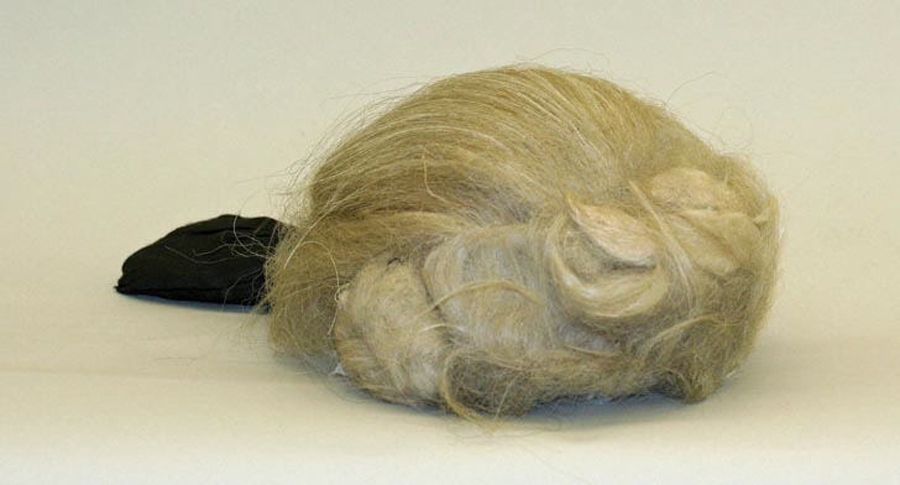
Hair weave is used for covering bald areas by using artificial hair integration. The hairs used for this purpose, may be human(obtained from hair cut of other people) or of synthetic origin. The purpose is to add length and fullness to the visible scalp. They are glued to remaining hairs or scalp, or sometimes fixed with clips (many other techniques of weaving are also available) ; which becomes loose over time and has a tendency to fall . As these are artificial, so they do not grow like normal hairs and for hair care a visit to hair stylist is mandatory in most occasions. Hence it is not a permanent solution like hair transplant.
The hair loss in male pattern baldness is due to the deleterious effect of dihydrotestosterone (DHT) in hair follicle. This results in the visible hair loss pattern seen in androgenic alopecia. But the hair growing on back of the head and the sides, are resistant to this negative impact of DHT, in contrast to hairs in rest of the head. This ensures the presence of these hairs even in most bald men, who have suffered hair loss in other areas of the scalp. This quality of hair follicles persists even if they are transplanted in other areas of scalp. This quality of these hair follicles is known as “donor dominance”, and forms the basic principle of hair transplant surgery.
So hair transplant surgery entails redistribution of the permanent hairs present in the backside of head to frontal hair line and other areas, which are desired to be covered. In hair transplant, no new hair is created as many mistakenly believe. To pull off this feat successfully, a combination of artistic aesthetic sense and perfect technical skill of a surgeon is needed. This combination is only possible in hands of a skilled plastic surgeon or an experienced dermatologist - who have an in depth knowledge of hair physiology and scalp anatomy.
Hair colouring is not advised 1 week before the procedure and hair should not be cut short -- as long hairs would help in camouflage of the donor site after the procedure. Medications which can increase the chances of bleeding should be stopped 1 week before the procedure, after medical consultation. These medications are; painkillers like Aspirin and Ibuprofen, vitamin E and garlic products. Smoking should be stopped at least 2 weeks before the surgery, so as not to impair the healing process. The same rule should also be applied for alcohol. A good night sleep is advised the night before the surgery. On the morning of the procedure, a shower and shampoo helps in keeping the surgical field clean. Loose fitting clothes should be worn to the surgical centre, which does not forcefully drag on the scalp, while wearing and removing the dress. A light break fast is advised 1 hour before the surgery.

Hair grafts are very tiny sized skin island containing permanent hair follicles, which are harvested from the back side of the head and implanted into the artificially made holes in frontal bald areas of scalp. The basic logic is like transplant of other body organs like - heart, liver and kidney, but with one major difference. As hair transplant is a transplant, where donor and recipient areas are in in same individual, so there is no chance of immune rejection, like organ transplant mentioned previously, which occurs between two different individuals.
So for surgery, individual follicular unit of hair ( the natural clusters in which hairs emerge from scalp & which is comprised of 1 to 4 terminal hairs) is extracted. This extraction of hair grafts are done in such a method, so that sufficient amount of hairs remain in the donor area, so as not to cause perceptible baldness in the donor area. There are two methods of extracting, these hair follicles from back of the head.
In FUT (Follicular Unit Transplantation) method or strip method, the donor tissue is harvested by cutting out a single strip of skin containing large group of hair follicles, from the back of the head . This is done under local anaesthesia, to avoid pain. Further dissection to isolate a single hair follicular unit from this large strip is by cutting with a surgical blade, and is done by assisting technical assistants under a dissecting microscope, to avoid inadvertent injury to the hair roots. The donor area is closed by surgical suture, which is removed approximately 10-12 days later, when this area is totally healed. Later the only evidence of surgery in this area is a fine scar, which remains invisible due to regrowth of adjacent hairs.
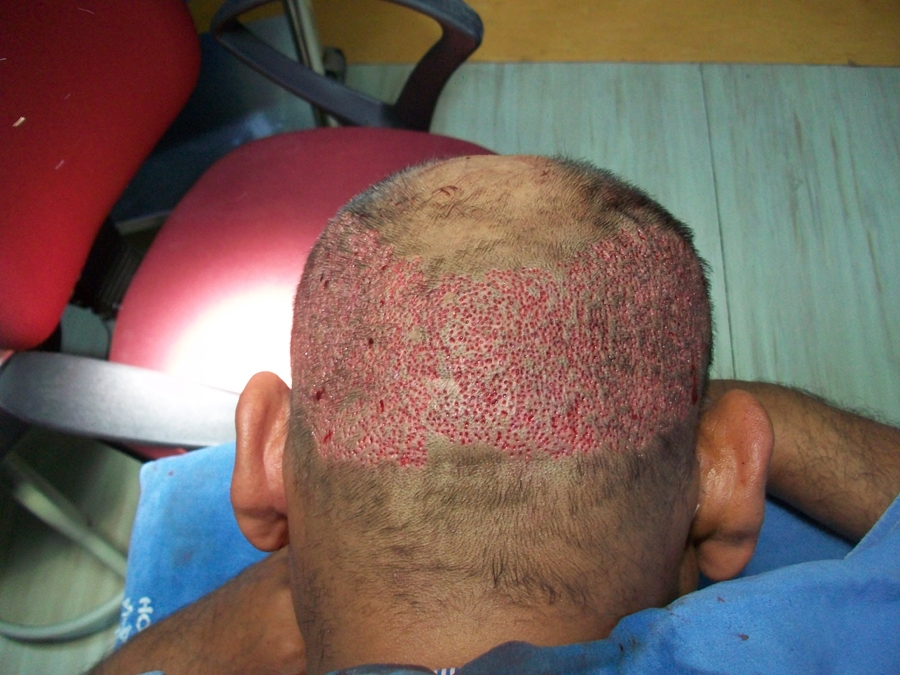
FUE (Follicular Unit Extraction) is an alternative method of hair follicle extraction, in which an individual follicular unit is extracted by using a specialised extraction instrument, directly from the scalp donor area. As there is no removal of big skin island, so healing of donor site is more rapid and relatively painless. This technique is sometimes also (wrongly) called as scar less method, as fine multiple punctate scar distributed over large area, is almost invisible.
The placement of grafts in the recipient area, starts with the marking of anterior hair line. The anterior most and middle portion of hair line lies approximately between 7.5 to 9.5 com above the area, between the two eyebrows (called as Glabella, in medical terms). Recipient site creation on previously demarcated area, begins with injection of haemostatic- anaesthetic liquid in this area. This ensues that when needles are used to puncture holes in this area, for placement of follicular graft, there is minimum bleeding and pain for the concerned patient.
The holes for placing grafts taken from back of the head, into the recipient area can be made by needle or special surgical blades. The holes are made in angles, in such a manner that when the graft produces a totally grown-up hair; it would mimic hair that would have been originally present in that site or non transplanted existing hairs in the area. Next the hair grafts which are extracted from donor area & placed in chilled water for hair preservation, is implanted one by one, in the minute holes created in the recipient site for this purpose. These are lengthy procedures and to transplant 3500 grafts by a team of 3-4 person would take around 8 hours, but of course the patient is allowed the use of washroom & meals or light snacks supplied in between the procedure. After completion of procedure, a small dressing is placed in the donor area.
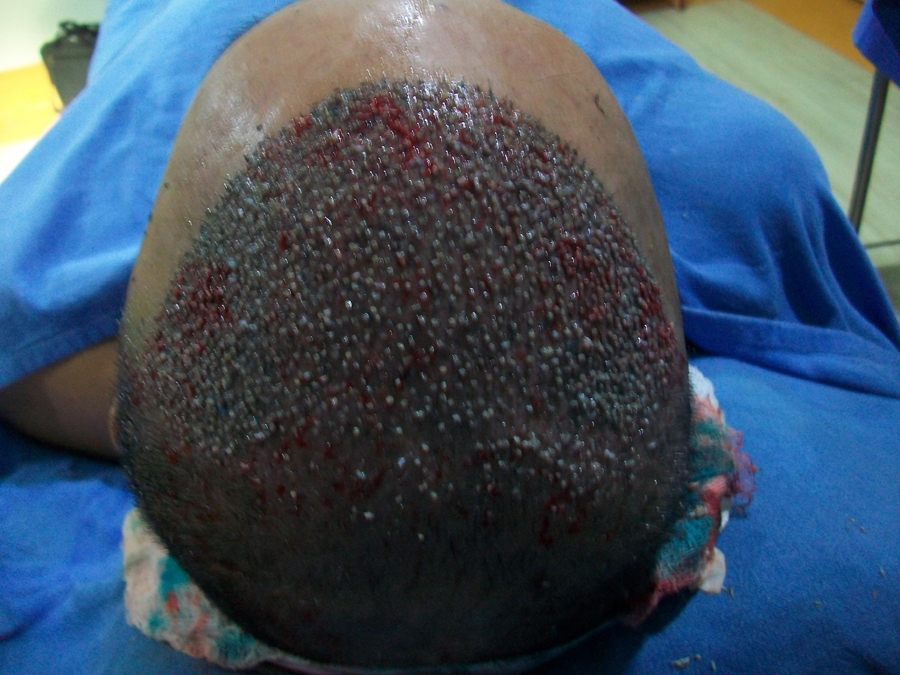
The person having the procedure should never drive back home, immediately after completion of the procedure. The patient is advised to take special care for the first 2 weeks following the procedure. Tight fitting T shirts, which causes friction against a person’s head, while wearing and removing, should be totally avoided. In this situation wearing shirts is better option. For at least 1 week it is advised to sleep in a position, with head elevated. This can be done by placing 3 to 4 pillows below the shoulder. Ice pack is applied to forehead (not in grafted area) to decrease swelling.
Spraying saline solution to the grafted area, hourly is advised in the first week. From the 6th day, a mild shampoo can be used . This should be rubbed between two hands to make a frothy rich lather, which is gently applied to the scalp. After a couple of minutes, this is washed with water, which is not under high pressure. Direct shower pressure is avoided till the 14th post op day. Hair styling products like- gel, foam or any kind of products should be avoided for at least 3 to 4 weeks. Hair dyes should be avoided for at least 2 months after the procedure.
Medications given after the procedure may include sleeping pill for the night of surgery & pain killers (aspirin and anti-inflammatory preparation which may cause bleeding, is avoided for first 5 days) and antibiotics for the next 5 to 7 days. After this period, Minoxidil sprays and Finasteride tablets can be started for the best results. If FUT procedure was used, then suture removal should be done on 10th post op day. As mentioned earlier smoking and alcohol should be avoided. Exercises should be avoided for initial 2 weeks and exposure to sun should be avoided for few months after the procedure.
The transplanted hairs would fall off during the first 2-3 months and many people would not even be able to make out that any surgery was done. Some patient may also suffer loss of hairs, that were present at the time of the procedure. This ‘shock loss’ is a temporary event, occurring due to injury suffered to the scalp during the surgical procedure. Hair always grows back from these areas, the only thing needed is patience.

After 3 to 4 months of the procedure, new hairs starts to grow in the transplanted area from the remaining hair roots. These hairs would be fine and soft. It is only by 9 to 10 months after the procedure, that the full benefits of the hair transplant surgery would be obvious in form of thicker, coarser and fuller hairs on the scalp.
It has to be understood, that every person who suffers from hair loss is different. The reason for this is that the cause of hair loss, may be different in different individuals. So formulating a standard treatment for all people, without identifying the cause of hair loss, is a terrible blunder committed by laymen, when they decide on self medication, without any expert medical opinion. So before deciding on a course of treatment, an opinion from a qualified Dermatologist or Plastic surgeon, should be taken. In hands of an expert qualified doctor hair transplant is a very simple and effective procedure for hair loss, which is much cheaper & safer than pursuing unconfirmed medicines for many years, without any formal medical opinion.